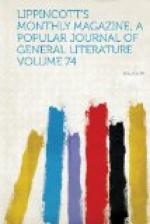[Illustration: Portico to the tombs of the emperors.]
Visits to the theatres, to the temple of the Moon, that of the Lamas, that of Confucius, and to others made the days spent in Pekin pass quickly. Among the wonders shown was the largest suspended bell in the world—the great bell of Moscow has never been hung—twenty-five feet high, weighing ninety thousand pounds, and richly sculptured.
The private life of the Chinese it is almost impossible for a stranger to take part in. To do so requires a knowledge of Chinese, which can be gained only by years of assiduous study, and that the applicant should, as far as possible in dress and general appearance, make himself a Chinese. Even then, complete success is gained only by a fortunate combination of circumstances. The streets devoted to shops of all kinds afford, however, to the traveler a never-ending succession of changing and interesting pictures. Yet the general spirit of the Chinese leads them also to be sparing of all outward decoration, reserving their forces for interior display. The Forbidden City even, though marvelous stories are told of its interior splendors, has outside a mean appearance. “A pagoda of the thirty-sixth rank has more effect than the sacred dwelling of the Son of Heaven.”
In the military quarters, and in those inhabited by the nobility, the party in their wanderings were struck with an expression of disdain on the countenances of those natives whom they met. Elsewhere the curiosity to see the foreigners was even greater than the Chinese themselves ever excited in the capitals of Europe; but at home the higher classes passed the foreigners without even turning to look at them, or else glanced at them indifferently or disdainfully. Some of the noble class walked, but generally they rode in carts similar to that of the mandarin Ching. The higher the rank of the owner, the farther behind are the wheels placed. With a prince’s cart they are so far behind that the rider hangs between them and the mule. Palanquins, carried upon the shoulders of the porters, offer another and the most convenient means of locomotion used in China: this method is, however, forbidden except for princes and ministers of state.
In the busy streets of trade the scene is most animated. Thousands of scarlet signs with gilded inscriptions hang from oblique poles raised in front of the shops. Carts, palanquins, mules, camels, coolies, soldiers and merchants throng the streets, while to add to the confusion myriads of children play about your legs, and the old men carrying their kites toward the walls add to the singularity of the scene. The kites, representing dragons, eagles, etc., are managed with a dexterity which comes only from a lifelong practice. They are sometimes furnished with various aeolian attachments which imitate the songs of birds or the voices of men. The pigeons also in Pekin are




